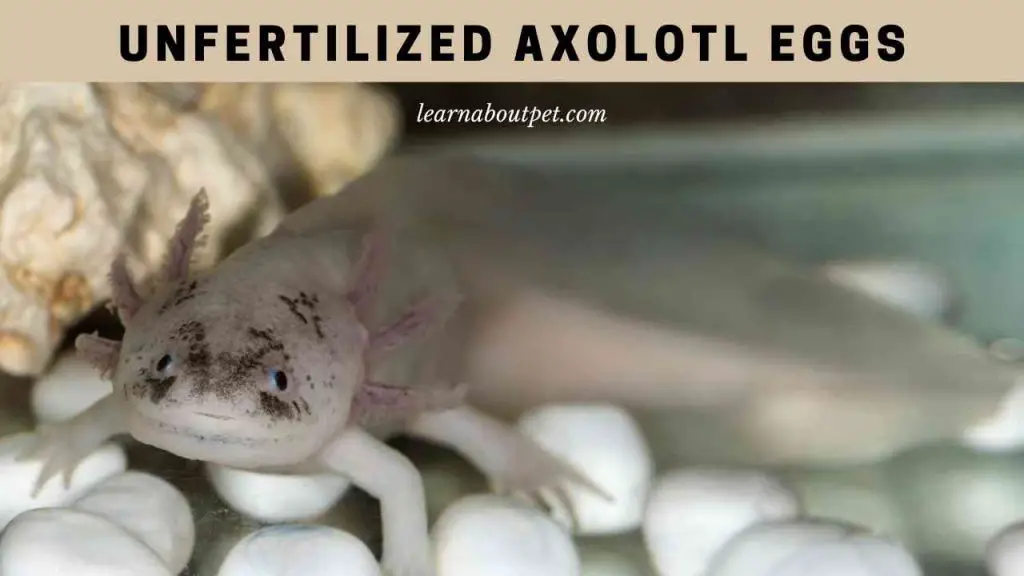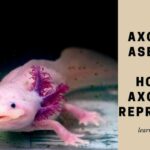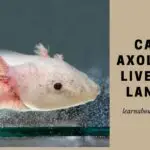If a female axolotl happens to lay eggs without a male, chances are that those would be unfertilized eggs. In this article, you will find information on whether axolotls can really lay such infertile eggs, and if yes, what they look like and what to do with them.
Normally, a female axolotl needs spermatophores (from a male) before laying eggs. But unfertilized axolotl eggs are not altogether unheard of. They are typically very small in number, relatively small in size with a cloudy or milky appearance.

Can Axolotls Lay Unfertilized Eggs?
To put it differently, do axolotls lay eggs that are infertile?
This question, on whether or not axolotls can lay infertile eggs is one that arouses a bit of controversy.
On the one hand, there are those who say that it is impossible for female axolotls to lay infertile eggs.
Then, on the other hand, there are those who say that whereas unfertilized axolotl eggs are a rarity, they are not altogether unheard of.
So, indeed, do axolotls lay infertile eggs? To put it more precisely, do female axolotls lay eggs without a male? Or can axolotls have babies without male?
The answer is yes. It is uncommon, but not altogether impossible to hear an axolotl owner proclaiming, my female axolotl has laid eggs without a mate.
Actually, such claims do come up in axolotl owner communities occasionally.
Do female axolotls lay unfertilized eggs regularly? Nobody says that. But what people assert is that it is possible for an axolotl to lay/leak infertile eggs, at least on occasion.
Why Would An Axolotl Lay Infertile Eggs?
In most cases, the axolotls that lay infertile eggs are those that are not yet fully mature. Axolotls start maturing (in reproductive terms) at roughly 12 months.
But they are only fully mature (for reproductive purposes) at 18 months usually.
So it is in that maturation period, between 12 months and 18 months that they typically lay the infertile eggs.
Most people refer to this as ‘leaking’ rather than really laying the infertile eggs.
There are also cases where fully mature female axies may lay such eggs for largely inexplicable reasons.
Unfertilized Axolotl Eggs – How Do They Look Like?
In other words, how do I know if axolotl eggs are fertilized? Or if it is a single egg, how do I know if my axolotl egg is fertilized?
Now how to tell if axolotl eggs are unfertilized is quite easy. You consider three things: their size, their number and their color.
In terms of size, infertile axolotl eggs will normally be much smaller than usual. They may be 0.2 cm in size. Yet normal fertile axie eggs are usually around 1.1 cm in size.
The smaller size may be due to the fact that they don’t get to go through all axolotl egg stages.
In terms of number, they will normally be fewer than usual. A female axolotl will not lay unfertilized egg as a whole batch. You won’t get the usual clutch size.
That is indeed why people refer to the expulsion of these eggs as ‘leaking’ rather than true ‘laying’.
In this context, it is important to understand, how many eggs do axolotls normally lay? And how many axolotl eggs survive under normal circumstances?

You find that normally, axolotls lay eggs in the 400 to 1,000 range. (Only around 20% of those may survive, at best).
But when it comes to unfertilized axolotl eggs, you may only find a handful: usually less than 20.
In terms of color, the infertile eggs will tend to be cloudy or milky in appearance.
Therefore if axolotl eggs are smaller than usual in size, fewer than usual and with a cloudy or milky appearance, they are probably infertile.
While at it, how do I know if my axolotl eggs are dead? The dead eggs are normally swollen, and if they were initially black, they start turning white.
How To Tell If Axolotl Eggs Are Fertilized?
At this point, it may also be important to learn how to tell if axolotl eggs are fertile. This way, you will be in a better position to differentiate them from infertile ones.
Telling if axolotl eggs are fertile is usually easy. They are usually of a normal color (black for ordinary axolotls, white for albino axolotls). They have jelly around them.
The individual eggs are of a normal size: normally around 1.1 cm.
And the clutch size is also of a normal size: typically with more than 100 eggs, and more commonly in the 400 to 1000 range.
Unfertilized Axolotl Eggs – What To Do With Them?
Most guides on how to care for axolotl eggs tend to be silent when it comes to infertile ones.
Of course, axolotl eggs hatching is out of question here: since these are infertile eggs.
So, what to do with them?
One option may be that of leaving them with the axolotl, which may then proceed to eat them.
Another option is that of simply disposing of them. Or feeding them to some other animal that is capable of eating them (for instance, the fish that eat them).
Final Verdict – Unfertilized Axolotl Eggs
In normal circumstances, female axolotls will only lay fertile eggs – after getting spermatophores from males. But there are also cases where they may lay (or leak) a few infertile eggs, even without a male.
The individual infertile axolotl eggs will normally be much smaller than normal ones. The eggs will also be fewer in number, and with a milky or cloudy appearance.

You can have the axolotl eat the infertile eggs it lays. You can feed them to other animals that are capable of eating them (like certain fish). Or you can otherwise dispose of them in any other responsible way.
As a pet lover, make sure to learn about pet more and give your pet axolotl a good and comfortable life!

Welcome to Learn About Pet. My name is Rajkumar Ravichandran and I love all pets, travel, and amazing food. I write about my passion and personal experience caring for multiple pets in this blog! ❤️
Post Disclaimer
DISCLAIMER: THIS BLOG OR WEBSITE, "Learn About Pet", DOES NOT PROVIDE YOU WITH MEDICAL ADVICE AND IS NOT A SUBSTITUTE FOR MEDICAL ADVICE. ALWAYS GET IN TOUCH WITH YOUR PERSONAL VETERINARIAN AND USE INFORMATION HERE AS GENERAL ADVICE.
The information, including but not limited to, text, graphics, images and other material contained on this website are for informational purposes only. No material on this site is intended to be a substitute for professional veterinary advice, food recommendation, diagnosis, or treatment. Always seek the advice of your veterinarian or other qualified health care provider with any questions you may have regarding a medical condition or for pet food related questions.







